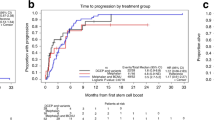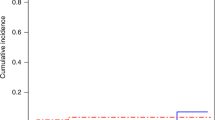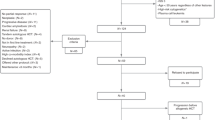Summary:
High-dose therapy (HDT) followed by autologous stem cell support is widely used as intensification treatment in patients with multiple myeloma (MM) responsive to the initial chemotherapy. However, there is growing evidence that only the subset of patients who achieve complete remission (CR) actually benefit from this approach. The aim of this study was to identify pretransplant predictors of CR in responding myeloma patients intensified with HDT. A total of 59 patients with chemosensitive disease received myeloablative therapy. The intensification regimen consisted of MEL-200 (23), MEL-140/TBI 12 Gy (21) or busulfan-based regimens (15). Serum and urine negative immunofixation were required for CR. After HDT, the CR rate increased from 8 to 37%. For the overall series, the median event-free survival (EFS) and overall survival (OS) from the initiation of therapy were 41 and 68 months, respectively. Patients who achieved CR had an EFS (median 47 vs 36 months; P=0.023) as well as an OS (median not reached vs 60 months; P=0.006) significantly longer than those attaining a lower degree of response. Finally, the pretransplant features significantly associated to CR were a low M-protein size (serum ⩽10 g/l and urine <0.5 g/24 h) (P=0.0003) and a proportion of bone marrow plasma cells of ⩽5% (P=0.02).
This is a preview of subscription content, access via your institution
Access options
Subscribe to this journal
Receive 12 print issues and online access
$259.00 per year
only $21.58 per issue
Buy this article
- Purchase on Springer Link
- Instant access to full article PDF
Prices may be subject to local taxes which are calculated during checkout


Similar content being viewed by others
References
Myeloma Trialists' Collaborative Group. Combination chemotherapy versus melphalan plus prednisone as treatment for multiple myeloma: an overview of 6,633 patients from 27 randomized trials. J Clin Oncol 1998; 16: 3832–3842.
Bladé J, San Miguel JF, Fontanillas M et al. Increased conventional chemotherapy does not improve survival in multiple myeloma: long-term results of two PETHEMA trials including 914 patients. Hematol J 2001; 2: 272–278.
Attal M, Harousseau JL, Stoppa AM et al. Autologous bone marrow transplantation versus conventional chemotherapy in multiple myeloma. N Engl J Med 1996; 335: 91–97.
Child JA, Morgan GJ, Davies FE et al. Medical Research Council Adult Leukaemia Working Party. High-dose chemotherapy with hematopoietic stem-cell rescue for multiple myeloma. N Engl J Med 2003; 348: 1875–1883.
Barlogie B, Jagannath S, Vesole DH et al. Superiority of tandem autologous transplantation over standard therapy for previously untreated multiple myeloma. Blood 1997; 89: 789–793.
Lenhoff S, Hjort M, Holmberg E et al. Impact on survival of high-dose therapy with autologous stem-cell support in patients younger than 60 years with newly diagnosed multiple myeloma. Blood 2000; 95: 7–11.
Palumbo A, Triolo S, Argentino C et al. Dose-intensive melphalan with stem cell support (MEL100) is superior to standard treatment in elderly myeloma patients. Blood 1999; 94: 1248–1253.
Fermand JP, Ravaud P, Katsahian S et al. High dose therapy (HDT) and autologous blood stem cell (ABSC) transplantation versus conventional treatment in multiple myeloma (MM): results of a randomized trial in 190 patients 55 to 65 years of age. Blood 1999; 94 (Suppl 1): 396a.
Segeren CM, Sonneveld P, van der Holt B et al. Dutch–Belgian Hemato-Oncology Cooperative Study Group. Overall and event-free survival are not improved by the use of myeloablative therapy following intensified chemotherapy in previously untreated patients with multiple myeloma: a prospective randomized phase 3 study. Blood 2003; 101: 2144–2151.
Alexanian R, Dimopoulos MA, Hester J et al. Early myeloablative therapy for multiple myeloma. Blood 1994; 84: 4278–4282.
Bladé J, San Miguel J, Fontanillas M et al. Survival of multiple myeloma patients who are potential candidates for early high-dose therapy intensification/autotransplantation who were conventionally treated. J Clin Oncol 1996; 94: 2167–2173.
Alexanian R, Weber D, Giralt S et al. Impact of complete remission with intensive therapy in patients with responsive multiple myeloma. Bone Marrow Transplant 2001; 27: 1037–1043.
Bladé J, Esteve J, Rives S et al. High-dose therapy autotransplantation/intensification vs continued standard chemotherapy in multiple myeloma in first remission. Results of a non-randomized study from a single institution. Bone Marrow Transplant 2000; 26: 845–849.
Chronic Leukaemia–Myeloma Task Force. National Cancer Institute: proposed guidelines for protocol studies. II. Plasma cell myeloma. Cancer Chemother Rep 1973; 4: 145–158.
Alexanian R, Haut A, Khan AU et al. Treatment for multiple myeloma. Combination chemotherapy with different melphalan dose regimens. JAMA 1969; 208: 1680–1685.
Blade J, San Miguel JF, Alcala A et al. Alternating combination VCMP/VBAP chemotherapy versus melphalan/prednisone in the treatment of multiple myeloma: a randomized multicentric study of 487 patients. J Clin Oncol 1993; 11: 1165–1171.
Alexanian R, Barlogie B, Tucker S . VAD-based regimens as primary treatment for multiple myeloma. Am J Hematol 1990; 33: 86–89.
Bladé J, Samson D, Reece D et al. Criteria for evaluating disease response and progression in patients with multiple myeloma treated with high-dose therapy and haemopoetic stem cell transplantation. Br J Haematol 1998; 102: 1115–1123.
Peto R, Pike MC . Conservatism of the approximation sigma (O-E)2-E in the log rank test for survival data or tumor incidence data. Biometrics 1973; 29: 579–584.
Lahuerta J, Martínez-Lopez J, de la Serna J et al. Remission status defined by immunofixation vs electrophoresis after autologous transplantation has a major impact on the outcome of multiple myeloma patients. Br J Haematol 2000; 109: 438–446.
Vesole DH, Barlogie B, Jagannath S et al. High-dose therapy for refractory multiple myeloma: improved prognosis with better supportive care and double transplants. Blood 1994; 84: 950–956.
Acknowledgements
The work was supported in part by the Grant FIS 00/0642 from the Fondo de Investigación Sanitaria, Spanish Ministry of Health, the Grant SGR 2001 00375 from the Generalitat de Catalunya, and Grants FIJC-02/P-CR and FITJC-02/ P-EM from the Jose Carreras International Leukemia Foundation.
Author information
Authors and Affiliations
Corresponding author
Rights and permissions
About this article
Cite this article
Nadal, E., Giné, E., Bladé, J. et al. High-dose therapy/autologous stem cell transplantation in patients with chemosensitive multiple myeloma: predictors of complete remission. Bone Marrow Transplant 33, 61–64 (2004). https://doi.org/10.1038/sj.bmt.1704313
Received:
Accepted:
Published:
Issue Date:
DOI: https://doi.org/10.1038/sj.bmt.1704313
Keywords
This article is cited by
-
Impact of Pre-transplant and Post-transplant Remission Status of Patients on Survival in Newly Diagnosed Multiple Myeloma
Indian Journal of Hematology and Blood Transfusion (2019)
-
Pattern of relapse and progression after autologous SCT as upfront treatment for multiple myeloma
Bone Marrow Transplantation (2014)
-
High-dose chemotherapy with autologous stem cell transplantation for multiple myeloma: what predicts the outcome? Experience from a developing country
Bone Marrow Transplantation (2009)
-
Outcomes after auto-SCT in African Americans with multiple myeloma
Bone Marrow Transplantation (2009)
-
Predictive factors for survival in myeloma patients who undergo autologous stem cell transplantation: a single-centre experience in 211 patients
Bone Marrow Transplantation (2006)



